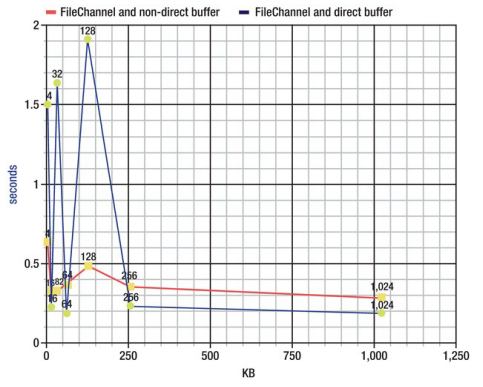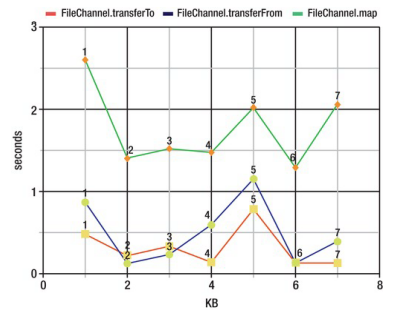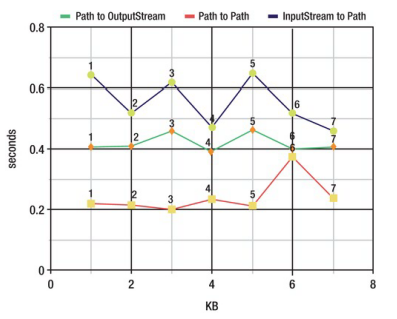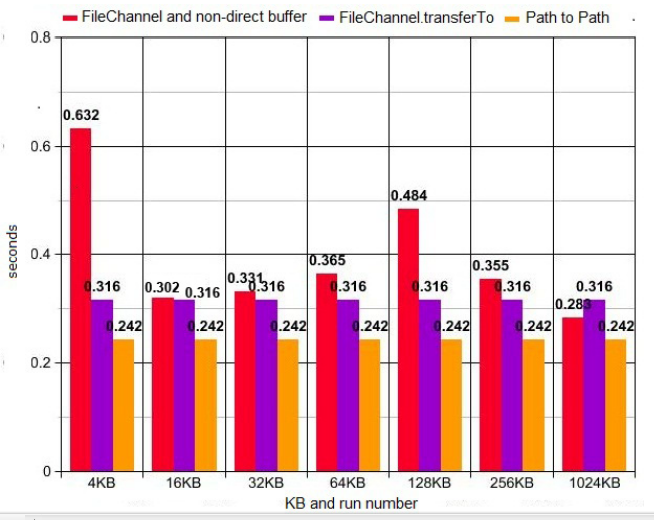Java 复制大文件方式(nio2 FileChannel 拷贝文件能力测试)
目前为止,我们已经学习了很多 Java 拷贝文件的方式,除了 FileChannel 提供的方法外,还包括使用 Files.copy() 或使用字节数组的缓冲/非缓冲流。那个才是最好的选择呢?这个问题很难回答,因为答案基于很多因素。本文将目光集中到一个因素,那就是速度,因为拷贝任务 越快将会提高效率,在有些情况下,这是成功的关键。因此,本文将使用一个应用程序来比较下面这些拷贝方式的具体时间:
- FileChannel 和非直接模式的 ByteBuffer
- FileChannel 和直接模式的 ByteBuffer
- FileChannel.transferTo()
- FileChannel.transferFrom()
- FileChannel.map()
- 使用字节数组和缓冲流
- 使用字节数组和非缓冲流
- File.copy()(Path 到 Path,InputStream 到 Path 和 Path 到 OutputStream)
应用程序基于下面的条件:
- 拷贝文件类型 MP4 视频(文件名为 Rafa Best Shots.mp4,所在目录为 C:\rafaelnadal\tournaments\2009\videos)
- 文件大小:58.3MB
- 测试的缓冲区大小:4KB, 16KB, 32KB, 64KB, 128KB, 256KB, and 1024KB
- 机器配置:Mobile AMD Sempron Processor 3400 + 1.80 GHz, 1.00GB RAM, 32-bit
OS, Windows 7 Ultimate - 测量类型:使用 System.nanoTime() 方法
- 连续运行三次后再获取时间;前三次运行将会被忽略。开始运行的时间总会比后面运行的时间要长一些。
下面将列出完整的应用程序:
import java.nio.MappedByteBuffer;
import java.io.OutputStream;
import java.io.InputStream;
import java.io.BufferedInputStream;
import java.io.BufferedOutputStream;
import java.io.File;
import java.io.FileInputStream;
import java.io.FileOutputStream;
import java.io.IOException;
import java.nio.ByteBuffer;
import java.nio.channels.FileChannel;
import java.nio.file.Files;
import java.nio.file.Path;
import java.nio.file.Paths;
import java.nio.file.StandardOpenOption;
import java.util.EnumSet;
import static java.nio.file.LinkOption.NOFOLLOW_LINKS; public class Main { public static void deleteCopied(Path path){ try {
Files.deleteIfExists(path);
} catch (IOException ex) {
System.err.println(ex);
} } public static void main(String[] args) { final Path copy_from = Paths.get("C:/rafaelnadal/tournaments/2009/videos/
Rafa Best Shots.mp4");
final Path copy_to = Paths.get("C:/Rafa Best Shots.mp4");
long startTime, elapsedTime;
int bufferSizeKB = 4; //also tested for 16, 32, 64, 128, 256 and 1024
int bufferSize = bufferSizeKB * 1024; deleteCopied(copy_to); //FileChannel and non-direct buffer
System.out.println("Using FileChannel and non-direct buffer ...");
try (FileChannel fileChannel_from = (FileChannel.open(copy_from,
EnumSet.of(StandardOpenOption.READ)));
FileChannel fileChannel_to = (FileChannel.open(copy_to,
EnumSet.of(StandardOpenOption.CREATE_NEW, StandardOpenOption.WRITE)))) { startTime = System.nanoTime(); // Allocate a non-direct ByteBuffer
ByteBuffer bytebuffer = ByteBuffer.allocate(bufferSize); // Read data from file into ByteBuffer
int bytesCount;
while ((bytesCount = fileChannel_from.read(bytebuffer)) > 0) {
//flip the buffer which set the limit to current position, and position to 0
bytebuffer.flip();
//write data from ByteBuffer to file
fileChannel_to.write(bytebuffer);
//for the next read
bytebuffer.clear();
} elapsedTime = System.nanoTime() - startTime;
System.out.println("Elapsed Time is " + (elapsedTime / 1000000000.0) + " seconds");
} catch (IOException ex) {
System.err.println(ex);
} deleteCopied(copy_to); //FileChannel and direct buffer
System.out.println("Using FileChannel and direct buffer ...");
try (FileChannel fileChannel_from = (FileChannel.open(copy_from,
EnumSet.of(StandardOpenOption.READ)));
FileChannel fileChannel_to = (FileChannel.open(copy_to,
EnumSet.of(StandardOpenOption.CREATE_NEW, StandardOpenOption.WRITE)))) { startTime = System.nanoTime(); // Allocate a direct ByteBuffer
ByteBuffer bytebuffer = ByteBuffer.allocateDirect(bufferSize); // Read data from file into ByteBuffer
int bytesCount;
while ((bytesCount = fileChannel_from.read(bytebuffer)) > 0) {
//flip the buffer which set the limit to current position, and position to 0
bytebuffer.flip();
//write data from ByteBuffer to file
fileChannel_to.write(bytebuffer);
//for the next read
bytebuffer.clear();
} elapsedTime = System.nanoTime() - startTime;
System.out.println("Elapsed Time is " + (elapsedTime / 1000000000.0) + " seconds");
} catch (IOException ex) {
System.err.println(ex);
} deleteCopied(copy_to); //FileChannel.transferTo()
System.out.println("Using FileChannel.transferTo method ...");
try (FileChannel fileChannel_from = (FileChannel.open(copy_from,
EnumSet.of(StandardOpenOption.READ)));
FileChannel fileChannel_to = (FileChannel.open(copy_to,
EnumSet.of(StandardOpenOption.CREATE_NEW, StandardOpenOption.WRITE)))) { startTime = System.nanoTime(); fileChannel_from.transferTo(0L, fileChannel_from.size(), fileChannel_to); elapsedTime = System.nanoTime() - startTime;
System.out.println("Elapsed Time is " + (elapsedTime / 1000000000.0) + " seconds");
} catch (IOException ex) {
System.err.println(ex);
} deleteCopied(copy_to); //FileChannel.transferFrom()
System.out.println("Using FileChannel.transferFrom method ...");
try (FileChannel fileChannel_from = (FileChannel.open(copy_from,
EnumSet.of(StandardOpenOption.READ)));
FileChannel fileChannel_to = (FileChannel.open(copy_to,
EnumSet.of(StandardOpenOption.CREATE_NEW, StandardOpenOption.WRITE)))) { startTime = System.nanoTime(); fileChannel_to.transferFrom(fileChannel_from, 0L, (int) fileChannel_from.size()); elapsedTime = System.nanoTime() - startTime;
System.out.println("Elapsed Time is " + (elapsedTime / 1000000000.0) + " seconds");
} catch (IOException ex) {
System.err.println(ex);
} deleteCopied(copy_to); //FileChannel.map
System.out.println("Using FileChannel.map method ...");
try (FileChannel fileChannel_from = (FileChannel.open(copy_from,
EnumSet.of(StandardOpenOption.READ)));
FileChannel fileChannel_to = (FileChannel.open(copy_to,
EnumSet.of(StandardOpenOption.CREATE_NEW, StandardOpenOption.WRITE)))) { startTime = System.nanoTime();
MappedByteBuffer buffer = fileChannel_from.map(FileChannel.MapMode.READ_ONLY,
0, fileChannel_from.size()); fileChannel_to.write(buffer);
buffer.clear(); elapsedTime = System.nanoTime() - startTime;
System.out.println("Elapsed Time is " + (elapsedTime / 1000000000.0) + " seconds");
} catch (IOException ex) {
System.err.println(ex);
} deleteCopied(copy_to); //Buffered Stream I/O
System.out.println("Using buffered streams and byte array ...");
File inFileStr = copy_from.toFile();
File outFileStr = copy_to.toFile();
try (BufferedInputStream in = new BufferedInputStream(new FileInputStream(inFileStr));
BufferedOutputStream out = new BufferedOutputStream(new FileOutputStream(outFileStr))) { startTime = System.nanoTime(); byte[] byteArray = new byte[bufferSize];
int bytesCount;
while ((bytesCount = in.read(byteArray)) != -1) {
out.write(byteArray, 0, bytesCount);
} elapsedTime = System.nanoTime() - startTime;
System.out.println("Elapsed Time is " + (elapsedTime / 1000000000.0) + " seconds");
} catch (IOException ex) {
System.err.println(ex);
} deleteCopied(copy_to); System.out.println("Using un-buffered streams and byte array ...");
try (FileInputStream in = new FileInputStream(inFileStr);
FileOutputStream out = new FileOutputStream(outFileStr)) { startTime = System.nanoTime(); byte[] byteArray = new byte[bufferSize];
int bytesCount;
while ((bytesCount = in.read(byteArray)) != -1) {
out.write(byteArray, 0, bytesCount);
} elapsedTime = System.nanoTime() - startTime;
System.out.println("Elapsed Time is " + (elapsedTime / 1000000000.0) + " seconds");
} catch (IOException ex) {
System.err.println(ex);
} deleteCopied(copy_to); System.out.println("Using Files.copy (Path to Path) method ...");
try {
startTime = System.nanoTime(); Files.copy(copy_from, copy_to, NOFOLLOW_LINKS); elapsedTime = System.nanoTime() - startTime;
System.out.println("Elapsed Time is " + (elapsedTime / 1000000000.0) + " seconds");
} catch (IOException e) {
System.err.println(e);
} deleteCopied(copy_to); System.out.println("Using Files.copy (InputStream to Path) ...");
try (InputStream is = new FileInputStream(copy_from.toFile())) { startTime = System.nanoTime(); Files.copy(is, copy_to); elapsedTime = System.nanoTime() - startTime;
System.out.println("Elapsed Time is " + (elapsedTime / 1000000000.0) + " seconds");
} catch (IOException e) {
System.err.println(e);
} deleteCopied(copy_to); System.out.println("Using Files.copy (Path to OutputStream) ...");
try (OutputStream os = new FileOutputStream(copy_to.toFile())) { startTime = System.nanoTime(); Files.copy(copy_from, os); elapsedTime = System.nanoTime() - startTime;
System.out.println("Elapsed Time is " + (elapsedTime / 1000000000.0) + " seconds");
} catch (IOException e) {
System.err.println(e);
}
}
}
输出结果排序比较复杂,其中包含了很多数据。下面我将主要的对比用图形的方式展示出来。图形中 Y 坐标表示消耗的时间(单位:秒),X 坐标表示缓冲的大小(或运行次数,跳过了前三次运行)。
FileChannel 和非直接模式 Buffer vs. FileChannel 和直接模式 Buffer
从下图看来,如果缓存小于 256KB,那么非直接模式的 Buffer 快一点,而缓存大于 256KB 后,直接模式的 Buffer 快一点:

FileChannel.transferTo() vs. FileChannel.transferFrom() vs. FileChannel.map()
从下图看来,FileChannel.transferTo() 和 FileChannel.transferFrom 运行七次的速度都差不多,而 FileChannel.map 的速度就要差很多:

三种 Files.copy() 方法
从下图看来,最快的是 Path 到 Path,其次是 Path 到 OutputStream,最慢的是 InputStream 到 Path:

FileChannel 和非直接模式 Buffer vs. FileChannel.transferTo() vs. Path 到 Path
最后,我们将前面最快的三种方式综合起来比较。从比较的结果来看,似乎 Path 到 Path 是最快的解决方案:

Java 复制大文件方式(nio2 FileChannel 拷贝文件能力测试)的更多相关文章
- AWS S3 递归上传文件和递归下载文件, 以及S3之间拷贝文件夹
1. 递归上传文件: aws s3 cp 本地文件夹 s3://bucket-name -- recursive --region us-east-1 2. 递归下载S3上的文件夹: cd 本地下载 ...
- cmake指定程序输出目录和库文件输出目录和拷贝文件
概述 本文样式环境: win10+cmake 3.18 本文将介绍使用CMAKE配置项目输出目录和 LIbrary项目的输出目录 本文将介绍 cmake的file函数的基础用法之拷贝文件 重点, 这些 ...
- java 模拟表单方式提交上传文件
/** * 模拟form表单的形式 ,上传文件 以输出流的形式把文件写入到url中,然后用输入流来获取url的响应 * * @param url 请求地址 form表单url地址 * @param f ...
- 从source folder 下将其所有子文件夹的*.* 文件拷贝到 target folder (不拷贝文件夹名仅拷贝文件)
因本人较懒,一直认为电脑能做的就让电脑来做,所以写下这个批处理的小脚本方便工作. 场景:碰到要拷贝一个文件夹(source folder)下的多个子文件夹(sub-folder)的文件到指定文件夹下( ...
- java中的拷贝文件FileChannel
以前用Java拷贝文件,只知道写byte数组循环拷贝,今天知道了可以用FileChannel进行拷贝,上代码: 下边是传统的byte数组拷贝方法 </pre><pre name=&q ...
- pythonl练习笔记——multiprocessing 多进程拷贝文件
分两份拷贝文件,父进程拷贝文件的前半部分,子进程拷贝文件的后半部分. import os import time #获取文件大小 size = os.path.getsize('wait.py') # ...
- 微软BI 之SSIS 系列 - 在 SSIS 中将指定目录下的所有文件分类输出到不同文件夹
开篇介绍 比如有这样的一个需求,旧的一个业务系统通常将产出的文件输出到同一个指定的目录下的不同子目录,输出的文件类型有 XML,EXCEL, TXT 这些不同后缀的文件.现在需要在 SSIS 中将它们 ...
- BAT文件语法和技巧(bat文件的编写及使用)
比较有用的东西 首先,批处理文件是一个文本文件,这个文件的每一行都是一条DOS命令(大部分时候就好象我们在DOS提示符下执行的命令行一样),你可以使用DOS下的Edit或者Windows的记事本(no ...
- java复制文件的4种方式
尽管Java提供了一个可以处理文件的IO操作类.但是没有一个复制文件的方法.复制文件是一个重要的操作,当你的程序必须处理很多文件相关的时候.然而有几种方法可以进行Java文件复制操作,下面列举出4中最 ...
随机推荐
- 适合新手的web开发环境
学习web开发,环境搭建是必不可少的一个环节.你可以使用wamp一键安装包,或者使用sae.bae.gae这种PaaS平台来部署,或者安装*nix系统在本地部署. 对于一个希望体验LAMP式建站的新手 ...
- wordpress后台进去空白怎么办?
最近博客换成了用wordpress程序搭建,内容和版面也重新设计.经常使用FTP工具,更改模板或者其他程序文件.由于对wordpress不太了解,竟然出现了wordpress后台进去空白的问题,而前台 ...
- Ninject中如果在抽象类中使用了属性注入,则属性必须设置为protected或public
Ninject中如果在抽象类中使用了属性注入,则属性必须设置为protected或public 不能使用private,否则无法注入成功,会报null异常
- php中直接执行mysqli_init()也是报Property access is not allowed yet的错误。
xdebug.auto_trace = On 和 xdebug.profiler_enable = On注释掉就OK了,不知道这两个配置项是干嘛的
- ASP.NET MVC之Ajax如影随行
一.Ajax的前世今生 我一直觉得google是一家牛逼的公司,为什么这样说呢?<舌尖上的中国>大家都看了,那些美食估计你是百看不厌,但是里边我觉得其实也有这样的一个哲学:关于食材,对于种 ...
- 单元测试+内存、SD卡、SP读写+XmlPullParser
测试: 测试的相关概念 1.根据是否知道源代码分类: 黑盒测试: a - b - c 边值测试 测试逻辑业务 白盒测试: 根据源代码写测试方法 或者 测试用例; 2.根据测试的粒度分类: 方法测试:写 ...
- QTableView和QTableWidget翻页功能实现
主要使用QTableView和QTableWidget中的三个函数实现 QTableView::verticalScrollBar()->setSliderPosition(): //设置当前 ...
- C++ 基础 杂类
1.set: 基本上跟map是相同(只有一个键),set是key-value 放在一起,map 是分开的,既然都加key ,所以set<> 的内容不可能有重复的情况出现 example: ...
- 有了这套flex页面布局方案,页面什么的,那都不是事。
一.CSS3弹性盒子弹性盒子是CSS3的一种新布局模式.CSS3 弹性盒( Flexible Box 或 flexbox),是一种当页面需要适应不同的屏幕大小以及设备类型时确保元素拥有恰当的行为的布局 ...
- JAVAEE——SSH项目实战06:统计信息管理、Spring注解开发和EasyUI
作者: kent鹏 转载请注明出处: http://www.cnblogs.com/xieyupeng/p/7190925.html 一.统计信息管理 二.Spring注解开发 1.service ...
